Back to page 1
The Design
 |
The way First Tennessee Park is oriented on its parcel of land has a huge impact on its design.
First, it opens to the south. "The ballpark orientation on this site was critical, because we knew it would be detrimental to turn the ballpark away from downtown," Boyd explained. "If we had oriented the ballpark north, as many traditional parks are, we would have lost that view of Nashville’s skyline and in turn, it would have also created a situation where we couldn’t have activated the street and would have negatively impacted circulation and the pedestrian walkway to the park."
Second, the park’s footprint doesn’t place homeplate near a corner of its parcel of land. As you probably know, ballparks were traditionally wedged into fairly square sites, usually bounded by city streets. Almost always, home plate would be near one corner of the lot, so the foul lines were almost exactly parallel with the streets outside the ballpark.
This wasn’t true, though, in one part of the country. In the Midwest, it was common for home plate to be near the center of the block, meaning the foul lines were at a 45-degree angle to the outside streets. This often meant that outfield dimensions were fairly short down the lines, but very deep to right center and left center. An excellent example of this is Milwaukee’s old Borchert Field, although Cleveland’s Municipal Stadium also had this layout, as does today’s Comerica Park in Detroit.
Well, Nashville, Tennessee isn’t exactly in the Midwest, but its new ballpark follows that locale’s layout. Home plate is halfway between 3rd Avenue and 5th Avenue, and the foul lines are at 45-degree angles to those streets. This permitted there to be a massive amount of area under-roof to the left and to the right of the grand entryway on Jackson Street. Therefore, instead of the home clubhouse being buried in the bowels of the stadium, it is on street level, just to the left of the entrance. Players then walk down a series of steps to get to the field.
Similarly, the huge kitchen and storage areas (below left) are on street level just to the right of the park’s entrance. It’s also nice that there’s natural light there, which isn’t always the case in prep areas like this.
 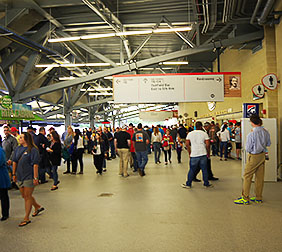 |
The layout of the ballpark’s structure also allows for wonderfully wide concourses (above right) that are fully open to the sunken field below. This is consistent with Populous’ tendency to design ballparks where fans walk into the park and onto the main concourses roughly on street level while the playing field is a good bit lower. This prevents the ballpark’s roof line from being ridiculously above the streets and sidewalks outside. In other words, it doesn’t have an overly tall profile.
The main grandstand stretches from the RF foul pole all around the infield to a point beyond the LF pole. With the main concourse at the rear of the seats, there is no need for cross concourses in the seating sections. This tends to make for better sightlines and a less cluttered look.
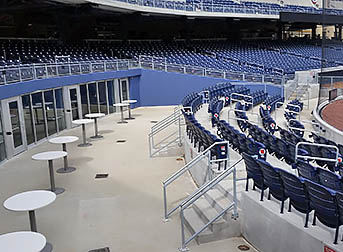 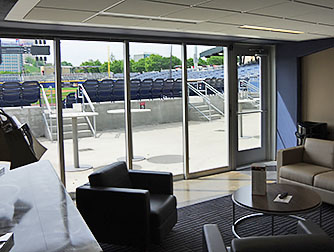 |
Just behind the backstop is an area devoted to the field level suites (above left). Here you have five rows of seats where you can almost touch the netting and an amazingly large open area where fans with these suite tickets can stand and mill about. Just behind this area, tucked under the field boxes, are four enclosed, air conditioned suites (above right). If you are the owner of one of these luxury suites, you can accommodate 33 guests in the seats by the backstop and another 22 inside the suite itself. Very nice.
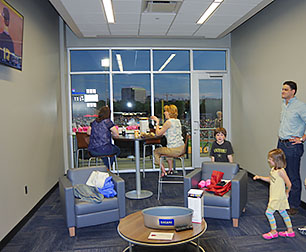 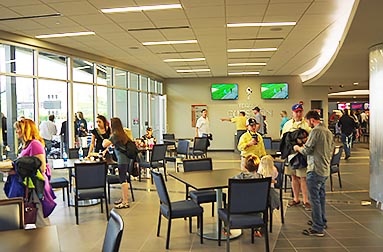 |
The upper level features 18 well-appointed suites (above left), with a 5,080-square-foot lounge with its own bar and concessions stands (above right). At each end of this upper level are Club Patio Decks, and each can accommodate up to 100 members of a group (below left).
The Club Level also offers far more seating sections than you would expect to find in a Triple-A park. There is good news and bad news in these seats, though. The good news is that your vantage point is nothing short of spectacular. You feel incredibly close to the action, which is due to "cantilevering" of this upper deck out toward the playing field (below right). I don’t know when I’ve ever felt so close to the players in an upper level. The not-so-good news, though, is that if you happen to be in a section that is far down the foul lines, you don’t have a quick way to exit the seating area. That’s because you aren’t allowed to use the steps that go up to the party decks to make your escape. You have to walk all the way down to the home-plate area to access the portal to the hallway behind the suites.
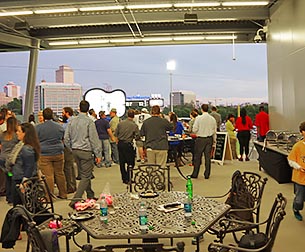 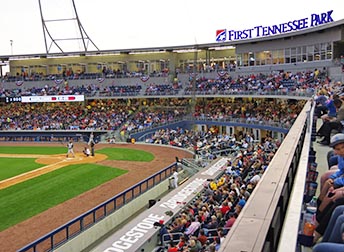 |
Another interesting aspect of the upper deck extending so far forward is that more rows on the field boxes are under cover than you would normally find. Because this blocks the illumination from the light towers, additional lighting was installed under the upper-deck seats to keep it from being too dark in the seats below — and believe me, without those lights, it would be pretty dim in those field boxes (below left).
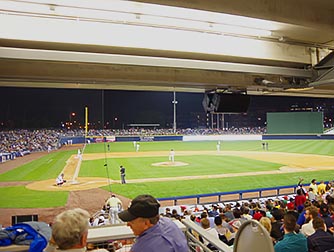 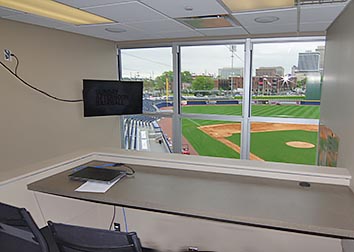 |
One other note about the design of FTP’s upper deck … while the placement of the pressbox is good (more or less behind home plate), I didn’t like the allocation of the space. While the booths for radio and TV broadcasters aren’t exactly spacious, the square footage for the "writing" press is ridiculously too small (above right). It has only two rows of three seats each — smaller than any Minor League park built in recent years.
I asked the Sounds’ Senior VP of Operations Doug Scopel, who was generous with his time in giving me a tour of the facilities, why the space for the press is so cramped. "We think it’s large enough," he responded. "We looked at the number of media members who covered our games at Greer last year, and I don’t think we ever had more than six at any one time. Plus, we can put writers in an auxiliary booth if we need to." While this may be true, I’m betting there will be more interest among publications in assigning writers to cover the team now that it’s in a new park. In addition, if FTP ever lands, say, the SEC baseball tournament, or Vanderbilt wants to play a Super Regional series here, there won’t be enough press space.
The outfield areas are well planned-out — and quite busy. With all of the emphasis on group areas these days, the designers of FTP incorporated numerous spots for groups to gather — and one (The Band Box) receives special mention in our next section…
Families, meanwhile, often like to gather on the grass berms in ballparks’ outfields or foul territories. At FTP, there is a tiny sliver of grass where you can see the field in right center field and a much wider space in left center. To me, though, it’s not enough. With all of the party decks, the huge batter’s eye and the service ramp so equipment can access the playing field, it didn’t leave enough acreage for berms.
  |
There are numerous nice touches in the design and "finishing" — some fans can see (like pillars and banners showing the city’s past baseball stars and the huge Sulphur Dell signage on the back of the batter’s eye, since the old playing field once existed in that very spot — see above right) and some they typically won’t (like the beautiful "reclaimed" wood forming one soaring wall in the entry lobby, below left).
And while it’s not exactly a "design" element, the most talked-about feature of the new park is clearly the guitar-shaped scoreboard. Greer Stadium had one, but it was nothing compared to the new version, as it spans 142 feet and displays game info and videos on the equivalent of 860 32-inch televisions. Truly it is FTP’s "iconic" element. In fact, do a little looking around at articles that describe this ballpark and see how many times the word "iconic" is paired with "scoreboard." To prove my point, I asked team owner Frank Ward to name his favorite feature of the new park. After quickly saying "everything!" he changed his response to "the iconic scoreboard."
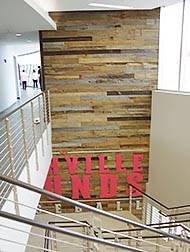 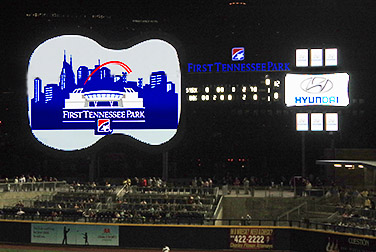 |
I’d be remiss if I didn’t mention the wonderful view of Nashville’s skyline from within the ballpark. This was a key to the site selection and orientation of the ballpark. It doesn’t offer the nearby skyscrapers of Charlotte’s BB&T BallPark, but FTP’s view is certainly one of the better ones in Triple-A.
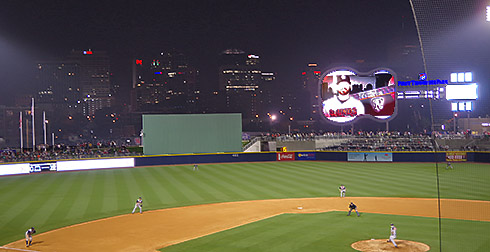 |
Speaking of Charlotte, its new park as well as El Paso’s are very, very special, partially because the odd elevations and shapes of the sites forced the designers to do unique things with the parks. That really wasn’t the case in Nashville, so consequently there aren’t as many elements that jump out at you. That’s not at all to say that FTP has a poor design or doesn’t "work." No, I think it works extremely well for the Sounds’ fans. It’s just that last year’s crop of new Triple-A parks set the bar ridiculously high, and I think years from now, we’ll still be reveling in how awesome Southwest University Park and BB&T BallPark are.
Let’s finish up our examination of FTP with a look at the cost of attending a game and what fans are finding at the concession stands.
The Essentials
 |
So what’s it like to attend a game at new First Tennessee Park?
First, you’ll need to find a place to park. Until the State finishes the 1,000-space parking garage beyond the park’s right field, you’ll most likely be looking at private lots along 3rd Avenue and in the State-owned lots along 5th Avenue. I saw spaces there costing $8-10.
At the box office (if you can find it behind the reflective glass), you’ll find the ticket prices to be a good bit higher than at Greer — but, hey, now you don’t have to sit in Greer! Like most new parks, there’s a wide range of prices, but for the most part, the non-premium seats aren’t unreasonably priced — plus you’ll save a little more when you purchase them in advance. The Club Seats on the upper level (with their wonderful proximity to the field) cost $30. Field boxes in the infield are called Premier Seats, and they cost $24, except the last few rows in those sections are only $17. The Select Seats are a little farther down the lines, and they cost $15, while Bullpen Seats are $11 and those hugging the foul poles ("Corner Seats) are $9. Add $2 to all of these prices when you’re buying them on the day of the game.
If you want to bring your family and sit on the berm, you’ll probably have a lot of company. Those tickets are $7, and are only sold in advance if all of the seats for the game have already been gobbled up.
 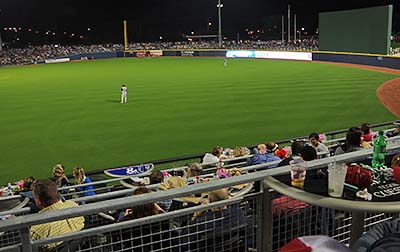 |
FTP is a ballpark that really caters to groups, but don’t think you can escape corporate sponsorships in the group areas. In left field is the immense Hyundai Deck (above left) that can accommodate groups of up to 600 (!). The cost is $27 per person without a reserved seat and $36 with one. In right field is the Vanderbilt Children’s Picnic Place that includes an all-you-can-eat buffet for up to 200 people. It’s $34 per person. Near it in RF is the &Vodka 4-Top area (above right) where for $70 you can claim a table for four with wait service. There’s room in this section for up to 108 fans.
One of the two Club Party Decks has a corporate name (Budweiser), and depending on the menu you select in the buffet, it’s $40 a person or more.
And of course the grand prize of group spaces are the Field Level Suites, as described above. Price? You have to speak with a group-sales rep with the Sounds to find out.
 |
The souvenir store (above) is a huge upgrade over the one in Greer Stadium, which measured 400 square feet. At FTP, you have nearly 3,000 square feet in which to shop, plus it opens onto the concourse during games and to the outside street on non-game days.
By the time I got to examine it on Opening Night, it was a little "picked over." I could still get a good sense of the prices, though. Kids’ T-shirts are $16 and $18, while for men they are mostly $20 and $25, while a few are $15. Women’s T’s are $20, $25 and $29. Adjustable caps for adults are $22 and $25, while fitted caps are $28. Kids’ caps cost $18.
The Sounds missed out on an opportunity when they failed to have commemorative lapel pins for the opening game. I bet quite a few of the 10,459 on hand would’ve liked one. Even worse, they had no pins in stock at all, which disappointed me since I collect them, and I’m not alone in that hobby.
The sound system at FTP is outstanding — as befits the municipality known as Music City. If you ever had the misfortune of attending a game at Greer, then you are familiar with what a poor PA system sounds like. Enough said.
But what about the food? You can stop wondering: it is excellent, and the stands selling it are cleverly named and well stocked. One reason for the high quality is because the concessions are handled by Centerplate, the food service vendor at two of the very best food ballparks in the Majors (AT&T Park and Safeco Field).
On the main concourse, there are four fixed stands: Music City Grill (featuring a pork chop sandwich topped with Tennessee Chow Chow at $7.50 and SF-style garlic fries at $5.00); Sulphur Dell Slices (featuring a Hunk of Pizza for $5.50 from the favorite of local convenience stores and gas stations, Hunt Brothers); Smokehouse BBQ (with the 4 Bagger, four delicious "house smoked" chicken drumsticks for $8.00); Hot or Not Chicken (with Nashville favorite Pepperfire Hot Chicken Tenders with waffle fries for $9.00).
 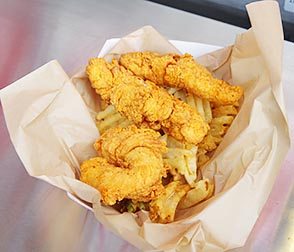  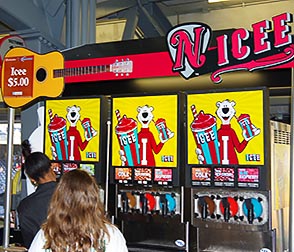 |
|
| Clockwise from upper left: Chow Chow Pork Chop Sandwich and Garlic Fries; Pepperfire Chicken Tenders, and they really are tender; the colorful ICEE stand; the 4 Bagger, with smoked drumsticks that are crispy on the outside but deliciously moist inside. | |
There are no fewer than 13 portable food stands, including The Sounds Shack (three street tacos for $8.00) and a stunning ICEE stand, both on the first-base side.
Perhaps the most noteworthy concession area is near the RF foul pole. "I grew up going to Nashville Sounds baseball games," said Max Goldberg, owner of Strategic Hospitality, operators of the most sophisticated and popular bars and bistros in Music City. "One day, I got a call, asking if I wanted to create something dynamic in the outfield area of the new ballpark." The result is The Band Box, "our interpretation of a really fun bar and restaurant in a baseball setting. And to do this for a team you grew up watching is really special."
No doubt, this area is a magnet for millennials — with its custom-designed furniture, exotic, high-end drinks, and incredibly inventive menu items. The guitar-shaped scoreboard might be the ballpark’s iconic symbol, but its soul is The Band Box (below).
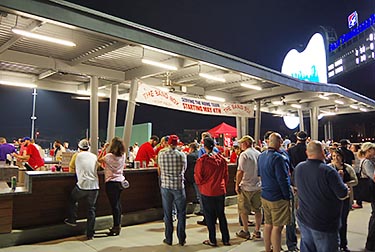 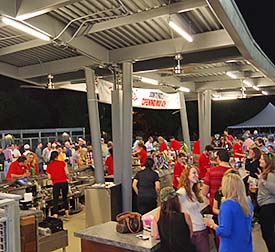 |
Summary
Opening night was an entertaining affair at FTP. From the Music City notables at the ribbon-cutting ceremony to the walk-off win in the bottom of the 10th to the fireworks — set off from the field, not beyond it — it was a night that saw baseball return to its roots in Nashville.
It had been over half a century since pro ball had been played on this spot, but as the headline over one article in the Tennessean put it, "Nashville baseball back where it belongs." Columnist Dave Ammenheuser also noted that the first game at FTP is when "baseball comes home to Sulphur Dell …"
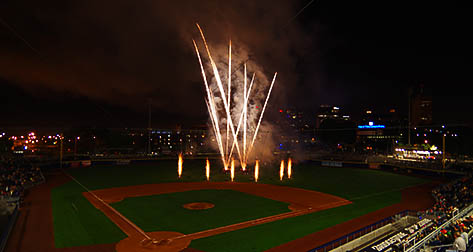 |
And it’s a hit with the fans. Over the course of the first month of the 2015 season, attendance was up 43% at FTP over the average in 2014.
If you’ve waded through the thousands of words in this review to reach this point, there’s one thing you’ve learned: Nashville’s new ballpark is a quantum leap forward from Nashville’s old ballpark. First Tennessee Park might not have the most stunning appearance or spectacular neighborhood (yet) … so, no, it’s not the best facility in the Pacific Coast League … but it is perfect for the fans of the Sounds. They’ve waited a long time for it — as have I — and I’m glad we all can enjoy it again and again.
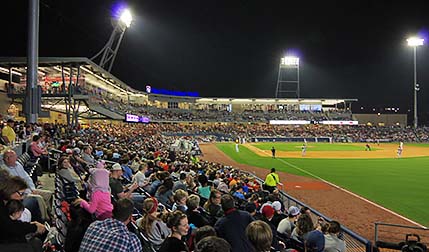 |
If you have thoughts about FTP or about this review, feel free to post a comment below.